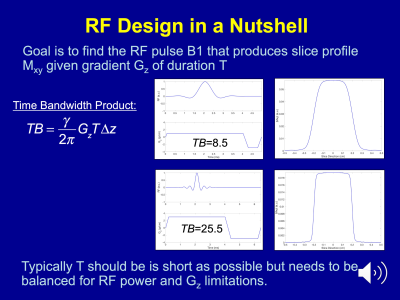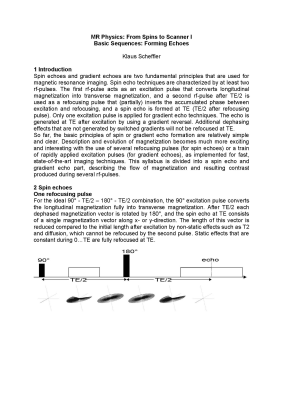Weekend Course
MR Physics: From Spins to Scanner I
ISMRM & SMRT Annual Meeting • 15-20 May 2021

| Concurrent 3 | 13:00 - 13:45 | Moderators: Ed Wu & Claudia Hillenbrand |
 |
Spins & Their Equations of Motion
Lars Hanson
The Bloch Equations underlying all MRI, describe the motion of the nuclear magnetization subject to magnetic fields. The spin dynamics are explored interactively directly in a browser to visualize important MR concepts. The connection between classical and quantum MR descriptions are discussed and common misunderstandings are addressed. The audience is encouraged to try the demonstrated software tools (the CompassMR and Bloch Simulators) to explore other MR techniques also. It requires no installation of software.
|
|
 |
Adding RF: Pulse Design
V. Andrew Stenger
This lecture will cover the basic concepts needed to understand the theory and implementation of slice-select RF pulses. Excitation k-space and the Fourier picture for small tip angle RF pulses will be covered. Common k-space trajectories and pulse designs will be discussed. Examples of 2D and 3D spatially selective excitations as well as spectral spatial pulse designs will be presented. Parallel transmission will be covered as well. Lastly we will cover the basics of Shinnar-LeRoux pulse design for larger flip angle pulses such as for refocusing.
|
|
| Generating Contrast in MRI
Penny Gowland
This talk will consider the basic sources of contrast in MRI and the contrast mechanisms. It will also consider how yo can calculate the dependency of MRI signal on relaxation times and how you can design sequences with different sensitivities to relaxation times.
|
||
| A Trip Through k-Space
Jianhui Zhong, Congyu Liao, Xiaozhi Cao
In this presentation, we will discuss how k-space can be explored to achieve different goals for imaging, and remedies for related issues and errors. First some basic of k-space and Cartesian scans will be presented, mostly on spin-warp and EPI that are commonly used in routine clinical practice. Then we will go to other trajectories such as spiral and radial, and use MRF and others as example. Finally strategies of undersampling to speed up and more advanced k-space methods are introduced.
|
||
 |
Basic Sequences: Forming Echoes
Klaus Scheffler
In spin echo techniques, the first rf-pulse acts as an excitation pulse that converts longitudinal magnetization into transverse magnetization, and a second rf-pulse after TE/2 is used as a refocusing pulse that (partially) inverts the accumulated phase between excitation and refocusing, and a spin echo is formed at TE. Only one excitation pulse is applied for gradient echo techniques. The echo is generated at TE after excitation by using a gradient reversal.
|
|
| Trajectories Gone Wild!
Craig Meyer
This educational talk will introduce the audience to the fundamentals, properties, and applications of non-Cartesian k-space sampling. The fundamentals of non-Cartesian imaging include sampling principles, pulse sequence design, and image reconstruction methods. Practical considerations for implementing non-Cartesian pulse sequences include gradient waveform design, k-space trajectory estimation, and correction for non-idealities such as main field inhomogeneity. Incorporating non-Cartesian trajectories into pulse sequences such as balanced SSFP and spin-echo train sequences involves interesting challenges and presents opportunities for faster and better imaging. Non-Cartesian sampling of 3D k-space enables highly-accelerated volumetric imaging. |
The International Society for Magnetic Resonance in Medicine is accredited by the Accreditation Council for Continuing Medical Education to provide continuing medical education for physicians.